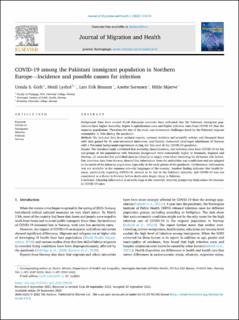| dc.contributor.author | Goth, Ursula-Georgine Småland | |
| dc.contributor.author | Lyshol, Heidi | |
| dc.contributor.author | Braaum, Lars Erik | |
| dc.contributor.author | Sørensen, Anette | |
| dc.contributor.author | Skjerve, Hilde | |
| dc.date.accessioned | 2022-10-04T12:32:38Z | |
| dc.date.available | 2022-10-04T12:32:38Z | |
| dc.date.created | 2022-09-27T11:02:48Z | |
| dc.date.issued | 2022 | |
| dc.identifier.citation | Journal of Migration and Health. 2022, 6, 100138. | en_US |
| dc.identifier.issn | 2666-6235 | |
| dc.identifier.uri | https://hdl.handle.net/11250/3023620 | |
| dc.description.abstract | Background
Data from several North European countries have indicated that the Pakistani immigrant populations have higher mortality, higher hospitalization rates and higher infection rates from COVID-19 than the majority populations. Therefore the aim of the study was to examine challenges faced by the Pakistani migrant community in Oslo during the pandemic.
Methods
We included data from national reports, national statistics and scientific articles and discussed them with data gained by 16 semi-structured interviews, and thereby elaborated challenges inhabitants of Norway with a Pakistani background experienced during the first year of the COVID-19 pandemic.
Results
The literature study confirmed that mortality, hospitalization, and infection rates from COVID-19 for the sub-groups of the populations with Pakistani background were consistently higher in Denmark, England and Norway, all countries that published data by ethnicity or origin, even when correcting for all known risk factors. Our interview data from Norway showed that information from the authorities was insufficient and not adapted to the needs of the minority population, especially in the early phases of the pandemic. Furthermore, information was not available in the common minority languages of the country. Another finding indicates that health literacy, particularly regarding COVID-19, seemed to be low in the Pakistani minority, and COVID-19 was not considered as a threat in Norway before death rates began rising in Pakistan.
Conclusion
Adapting information at an early stage to the countries’ minority groups may help reduce the increase in COVID-19 rates. | en_US |
| dc.language.iso | eng | en_US |
| dc.rights | Attribution-NonCommercial-NoDerivatives 4.0 Internasjonal | * |
| dc.rights.uri | http://creativecommons.org/licenses/by-nc-nd/4.0/deed.no | * |
| dc.title | COVID-19 among the Pakistani immigrant population in Northern Europe––Incidence and possible causes for infection | en_US |
| dc.title.alternative | COVID 19 among the Pakistani immigrant population in Norther Europe - incidence and possible causes for infections | en_US |
| dc.type | Peer reviewed | en_US |
| dc.type | Journal article | en_US |
| dc.description.version | publishedVersion | en_US |
| dc.source.pagenumber | 7. | en_US |
| dc.source.volume | 6 | en_US |
| dc.source.journal | Journal of Migration and Health | en_US |
| dc.identifier.cristin | 2055801 | |
| dc.source.articlenumber | 100138 | en_US |
| cristin.ispublished | false | |
| cristin.fulltext | original | |
| cristin.qualitycode | 1 | |

